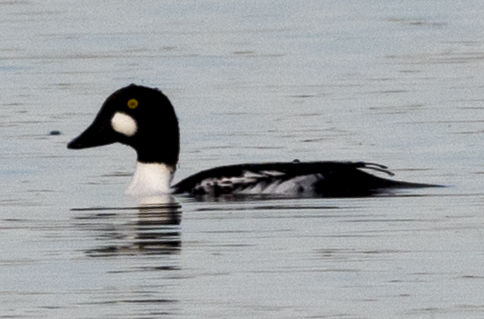A standard long walk around - in warm sunshine! On Crytal/Elf/Conoco pools there were many Black-headed Gulls and a pair of Mediterranean Gulls, together with quite a few Greylag Geese. Pochard, Mallard and Tufted Duck. There were two Oystercatchers and one Snipe at the waters edge at the front of one of the islands. There were a few Little and Great Crested Grebes, together with Coot and one Moorhen over the water.
There was a Robin and Chaffinch singing on the other side of the path to the Pinnacle lookout mound. The viewing mound over Radar was dominated by the Black-headed Gulls, displaying, attempting to mate and always excitedly calling. There were also at least two pairs of Mediterranean Gulls, together with two pairs of Oystercatchers. Always wandering in among the gulls are Jackdaws, who seem to be moderately tolerated, and a few duck settled down comfortably such as Pochard.
Waders resting up on the islands at the high tide peak included a couple of dozen Common Redshanks, about five hundred Black-tailed Godwits and and over a hundred Avocets, although I didn't see any Dunlin on Radar Pool today.
On the water there were Tufted Duck, Pochard, a few Pintail and Shoveller and a large raft of Wigeon. Coots, Little Grebes and Great Crested Grebes. There were Greylag Geese and Shelduck at the back by Hidden Pool.
Walking on to Black Barn Pools to eat my sandwiches in the sunshine, I passed several Cetti's Warblers hiding in the ditches who briefly sang at me. On the pools there were Pochard, Shoveller, Mallard, Tufted Duck, Coot, Little Grebe, Great Crested Grebe, a few Black-headed Gulls and two Little Egrets.
On Flamingo Pool, there were about a dozen Ringed Plovers, at least two Dunlin, Lapwing, many dozen Common Redshank, Avocets (largely moved from Radar?), and at least two Curlew. Pochard, Tufted Duck, Mallard, at least one remaining pair of Goldeneye, the male being a first winter bird, with head colours morphing into the blackish of the adult with the white patch, but still with the odd headshape, brownish eye, and darkish flanks of the young bird, a few Shoveller, Shelduck, more Coot, Great Crested (a pair displaying in the distance, probably on Hidden Pool) and Little Grebes. Black-headed Gulls, and then a Barn Owl hunting over the marsh at the back.
The male first winter bird, with head colours morphing into the blackish of the adult with the white patch, but still with the odd headshape, brownish eye, and darkish flanks of the young bird. A few months ago it would have been nearly indistinguishable from a female, but would have lacked the yellow bill tip. It is sitting quite low in the water.
There was a Little Egret quite close before I left.
There were Blackbirds, Robins, Chaffinches and a Great Tit singing along the track back to the car.
There was a Robin and Chaffinch singing on the other side of the path to the Pinnacle lookout mound. The viewing mound over Radar was dominated by the Black-headed Gulls, displaying, attempting to mate and always excitedly calling. There were also at least two pairs of Mediterranean Gulls, together with two pairs of Oystercatchers. Always wandering in among the gulls are Jackdaws, who seem to be moderately tolerated, and a few duck settled down comfortably such as Pochard.
Waders resting up on the islands at the high tide peak included a couple of dozen Common Redshanks, about five hundred Black-tailed Godwits and and over a hundred Avocets, although I didn't see any Dunlin on Radar Pool today.
On the water there were Tufted Duck, Pochard, a few Pintail and Shoveller and a large raft of Wigeon. Coots, Little Grebes and Great Crested Grebes. There were Greylag Geese and Shelduck at the back by Hidden Pool.
Walking on to Black Barn Pools to eat my sandwiches in the sunshine, I passed several Cetti's Warblers hiding in the ditches who briefly sang at me. On the pools there were Pochard, Shoveller, Mallard, Tufted Duck, Coot, Little Grebe, Great Crested Grebe, a few Black-headed Gulls and two Little Egrets.
On Flamingo Pool, there were about a dozen Ringed Plovers, at least two Dunlin, Lapwing, many dozen Common Redshank, Avocets (largely moved from Radar?), and at least two Curlew. Pochard, Tufted Duck, Mallard, at least one remaining pair of Goldeneye, the male being a first winter bird, with head colours morphing into the blackish of the adult with the white patch, but still with the odd headshape, brownish eye, and darkish flanks of the young bird, a few Shoveller, Shelduck, more Coot, Great Crested (a pair displaying in the distance, probably on Hidden Pool) and Little Grebes. Black-headed Gulls, and then a Barn Owl hunting over the marsh at the back.
The male first winter bird, with head colours morphing into the blackish of the adult with the white patch, but still with the odd headshape, brownish eye, and darkish flanks of the young bird. A few months ago it would have been nearly indistinguishable from a female, but would have lacked the yellow bill tip. It is sitting quite low in the water.
There was a Little Egret quite close before I left.
There were Blackbirds, Robins, Chaffinches and a Great Tit singing along the track back to the car.




